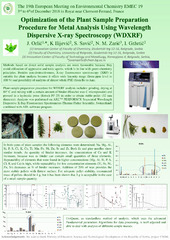Приказ основних података о документу
Optimization of the plant sample preparation procedure for metal analysis using Wavelength Dispersive X-Ray Spectroscopy (WDXRF)
| dc.creator | Orlić, Jovana | |
| dc.creator | Ilijević, Konstantin | |
| dc.creator | Savić, Slađana D. | |
| dc.creator | Zarić, Nenad M. | |
| dc.creator | Gržetić, Ivan | |
| dc.date.accessioned | 2023-07-21T09:27:17Z | |
| dc.date.available | 2023-07-21T09:27:17Z | |
| dc.date.issued | 2018 | |
| dc.identifier.uri | https://emec19.sciencesconf.org/data/pages/EMEC_19_Book_of_abstract.pdf | |
| dc.identifier.uri | http://cherry.chem.bg.ac.rs/handle/123456789/5919 | |
| dc.identifier.uri | http://www.europeanace.com/about/meetings | |
| dc.identifier.uri | https://emec19.sciencesconf.org | |
| dc.identifier.uri | http://cherry.chem.bg.ac.rs/handle/123456789/5920 | |
| dc.description.abstract | Plants are known as good biomonitors in contaminated areas due to their tendency to accumulate toxic metals. Methods based on direct solid sample analysis are more favourable because they avoid utilization of aggressive and toxic agents, which is in line with green chemistry principles [1]. Besides nondestructiveness, X-ray fluorescence spectroscopy (XRF) is suitable for plant analysis because it offers wide linearity range (from ppm level to 100 %) and possibility of analysis of almost whole PSE (from Be to Am) [2]. Plant sample preparation procedure for WDXRF analysis includes grinding and drying at 60 C. After obtaining a homogeneous mixture, the plant sample is mixed with a certain amount of binder (Hoechst wax C micropowder) and pressed in a hydraulic press (Retsch PP 25) in order to obtain stable pellet (32 mm diameter). The plants are mostly made of light elements (O, N and C) which are transparent for X-rays. During analysis of elements with a higher atomic number, Xrays penetrate quite deep into the sample. It is important to establish the minimum thickness of the pellet that will provide reliable results during determination of the heavier elements in the plant matrix. Samples are measured under conditions of high vacuum and slightly elevated temperature, and for that reason herbal matrix is prone to physical changes after analysis. It is important to determine ideal ratio between mass of the sample and the binder that will provide a stable pellet without affecting determination of elements which are present in low concentrations. During this study, two types of plant samples were analysed: fir and pine needles. Samples were collected in 2017 during autumn. The influence of pellet mass (thickness) on elements concentration was examined by measuring pellets prepared from 1, 2, 3, 4 or 5 g of plans material. By preparing pellets with: 0, 5, 10, 15, 20 and 25 % of wax, the influence of binder ratio was examined. Analysis was performed on ARL™ PERFORM’X Sequential Wavelength Dispersive XRay Fluorescence Spectrometer (Thermo Fisher Scientific, Switzerland) combined with ARL software program UniQuant [3]. In both types of plant samples the following elements were determined: Na, Mg, Al, Si, P, S, Cl, K, Ca, Ti, Mn, Fe, Ni, Zn, Sr and Zr. Both fir and pine needles show similar trends. As quantity of binder increases, the concentration of Ca and K increases, because wax as binder can contain small quantities of those elements. Repeatability of elements that were found in higher concentrations (Mg, Al, Si, P, S, Cl, K and Ca) is high, while repeatability for low concentration elements (Ti, Fe, Ni, Zn, Sr) decreases as percent of binder increases. Reason for that phenomenon is that dilution with wax is affecting elements in low concentration more than high concentration elements. For light elements results show small impact of pellet mass on the measurements because observed X-rays have low penetration depth. Elements with higher Z number are usually present in smaller concentrations in plants and such measurements are less precise, especially when the smaller pellet mass is analyzed. We can say that UniQuant, as standardless method of analysis, which uses the advanced Fundamental parameters Algorithms for data processing, is well adjusted and able to deal with analysis of different sample masses. When physical properties of pellets are investigated, addition of 20% of wax provides the most stabile pellets with flattest surface. For adequate pellet stability, recommend mass of pellets should be 4 g, but it has been shown that 3 g is acceptable in the case of a small sample quantity. In case when we have less than 3 g, it is recommended to carefully place sample as thin layer on the top of 3 g of boric acid inert carrier. | sr |
| dc.language.iso | en | sr |
| dc.publisher | Institute of Chemistry of Clermont-Ferrand (ICCF) from the Clermont Auvergne University | sr |
| dc.publisher | CNRS | sr |
| dc.publisher | Sigma-Clermont | sr |
| dc.relation | info:eu-repo/grantAgreement/MESTD/Basic Research (BR or ON)/176006/RS// | sr |
| dc.rights | openAccess | sr |
| dc.rights.uri | https://creativecommons.org/licenses/by/4.0/ | |
| dc.source | 19th European Meeting on Environmental Chemistry, Royat, France, 4-6th December | sr |
| dc.subject | XRF | sr |
| dc.subject | Plant samples | sr |
| dc.subject | metal determination | sr |
| dc.subject | Green chemistry | sr |
| dc.title | Optimization of the plant sample preparation procedure for metal analysis using Wavelength Dispersive X-Ray Spectroscopy (WDXRF) | sr |
| dc.type | conferenceObject | sr |
| dc.rights.license | BY | sr |
| dc.description.other | The conference was organized by the Institute of Chemistry of Clermont-Ferrand (ICCF) from the Clermont Auvergne University / CNRS / Sigma-Clermont, on behalf of the Association of Chemistry and the Environment (ACE). | sr |
| dc.type.version | publishedVersion | sr |
| dc.identifier.fulltext | http://cherry.chem.bg.ac.rs/bitstream/id/32929/bitstream_32904.pdf | |
| dc.identifier.rcub | https://hdl.handle.net/21.15107/rcub_cherry_5920 |


